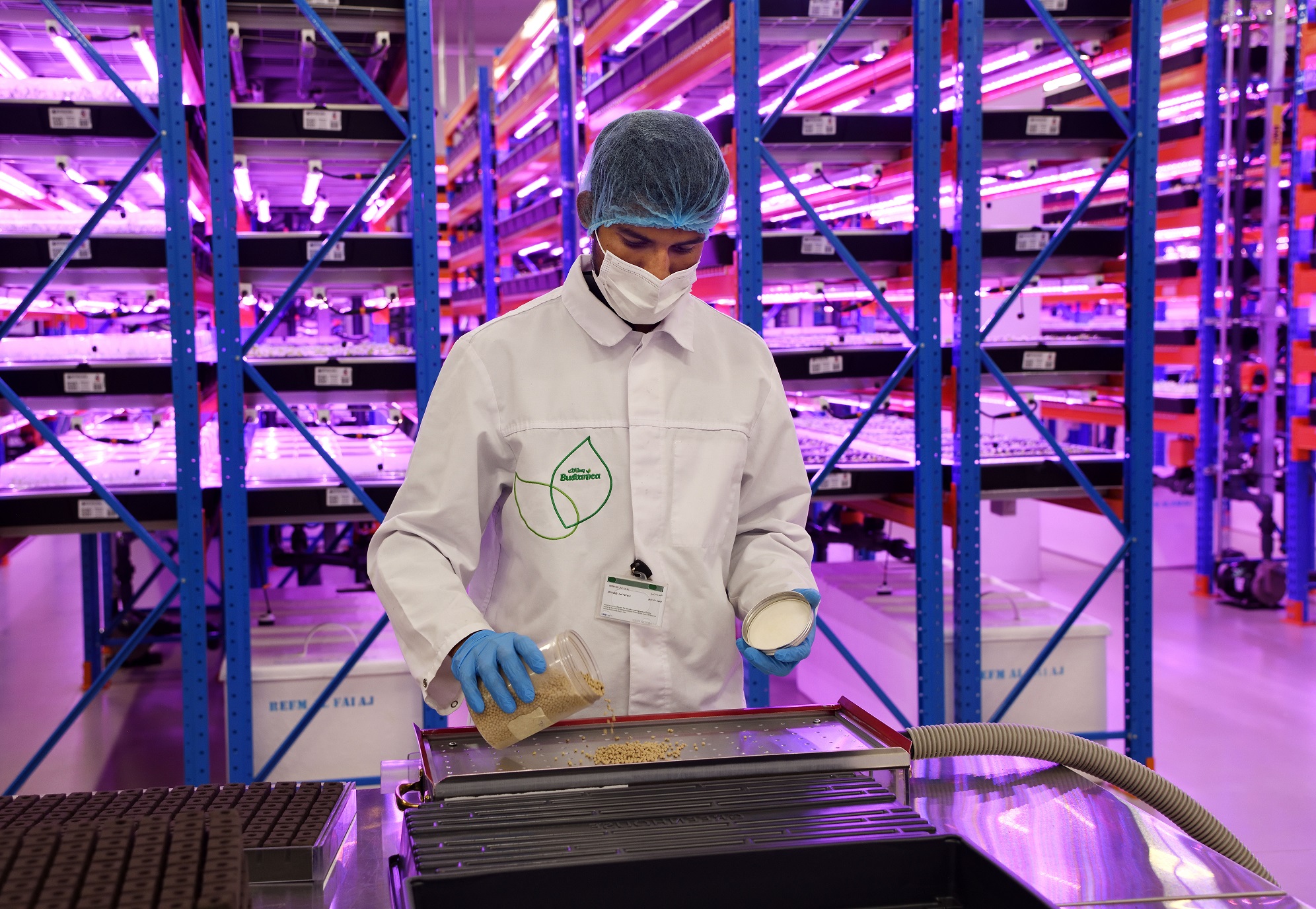I grow leafy green vegetables in the desert.
 Here in the United Arab Emirates, we live not far from the birthplace of agriculture, but despite this find ourselves surrounded by sand with the challenge of access to arable land. The UAE is so hot that summertime temperatures can soar to 50 degrees Celsius (120 degrees Fahrenheit). Fresh water is in short supply, and it evaporates quickly.
Here in the United Arab Emirates, we live not far from the birthplace of agriculture, but despite this find ourselves surrounded by sand with the challenge of access to arable land. The UAE is so hot that summertime temperatures can soar to 50 degrees Celsius (120 degrees Fahrenheit). Fresh water is in short supply, and it evaporates quickly.
Agriculture in the region previously has been limited, with most cultivated land dedicated to date palms, but recently major investment has been made in sustainable agriculture ventures.
This nation of more than 9 million people needs fresh water and healthy food. Much of the water comes from desalination plants. As for food, the UAE imports a lot of it, including as much as 90 percent of the produce consumed by Emiratis and others in the country.
 My opportunity as a farmer is to improve this situation. For the last year and a half, I’ve devoted myself to building and operating an amazingly efficient and sustainable farm that allows the people of the UAE to do something they rarely have had the chance to do in the past: Eat fresh produce grown near where they live all year round.
My opportunity as a farmer is to improve this situation. For the last year and a half, I’ve devoted myself to building and operating an amazingly efficient and sustainable farm that allows the people of the UAE to do something they rarely have had the chance to do in the past: Eat fresh produce grown near where they live all year round.
I’m originally from Australia, where farmers always have struggled with a dry climate and face the constant threat of drought. Anybody who has spent time around Australian agriculture knows that water is a precious and scarce resource. It’s etched in your mind from a young age.
Australia’s harsh reality has encouraged me to think about how technology can create new ways to raise crops. This led to my interest in hydroponics, a method that involves growing plants without soil and permits the radical conservation of water.
My first significant professional opportunity in hydroponics came in Vietnam, where I helped develop an agricultural company committed to the sustainable production of local, fresh, and healthy produce. We had a large greenhouse and orchards. We also had several shipping-container farms that featured hydroponics, with crops whose roots don’t touch soil but instead dangle into nutrient-rich water.
Vietnam has an abundance of water, but much of its quality is poor, due to pollution, plastic waste, and heavy metals leaking from old pipes. We were also facing salt water intrusion in the Mekong River, a source of water many farmers have relied on for generations. Hydroponics offer a way to meet this challenge.
In time, I ventured out with my own company, which allowed me to help restaurants and schools develop hydroponic systems that fit their operations and meet their needs. I also worked to educate people on the value and potential of hydroponics and this sustainable food production practice.
This is what drew me to the UAE—and the construction of the world’s largest indoor vertical farm.
 From the outside, it looks like a warehouse. Inside, we’ve pioneered a new approach to food production. Whereas a traditional farm spreads across acres of fields horizontally, our hydroponic farm scales upward vertically, in a series of levels like a tower. We grow leafy green vegetables and microgreens without soil or additives, providing high-quality produce throughout the year rather than seasonally. We can pack it and ship it quickly. Within a day of harvest—and sometimes on the very same day—consumers can enjoy our lettuce, spinach, kale, arugula, and parsley.
From the outside, it looks like a warehouse. Inside, we’ve pioneered a new approach to food production. Whereas a traditional farm spreads across acres of fields horizontally, our hydroponic farm scales upward vertically, in a series of levels like a tower. We grow leafy green vegetables and microgreens without soil or additives, providing high-quality produce throughout the year rather than seasonally. We can pack it and ship it quickly. Within a day of harvest—and sometimes on the very same day—consumers can enjoy our lettuce, spinach, kale, arugula, and parsley.
That’s when food tastes best. Our vegetables are both healthy and delicious.
In the parched environment of the UAE, the key to our success is the conservation of water through hydroponics. We use 95 percent less water than traditional methods of farming. We give the crops exactly what they need to grow, and we recycle what they don’t use.
 We even capture water from the air. Because our crops perspire, generating humidity, the very atmosphere of our vertical farm is a resource. Our advanced HVAC system converts this moisture into condensate water and delivers it to our reverse-osmosis plant, which treats the water and allows us to put it back into our agricultural mission.
We even capture water from the air. Because our crops perspire, generating humidity, the very atmosphere of our vertical farm is a resource. Our advanced HVAC system converts this moisture into condensate water and delivers it to our reverse-osmosis plant, which treats the water and allows us to put it back into our agricultural mission.
At our hydroponic farm, every drop of water goes directly into food production. As we do more with less, the UAE becomes more self-sufficient and food secure.
With hydroponic technology applied as an agricultural practice to improve both water sustainability and water quality, we are showcasing another example of sustainable farming at work that is improving food security.


